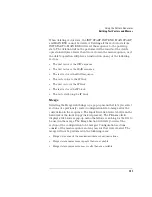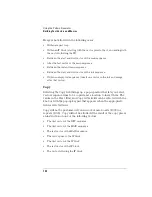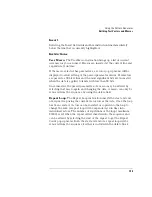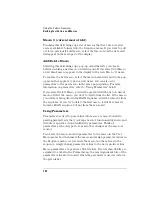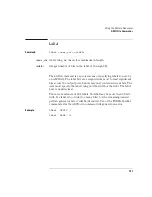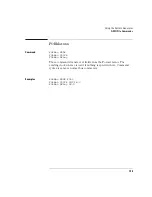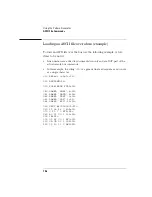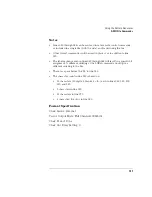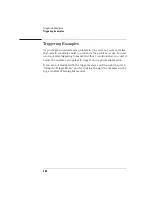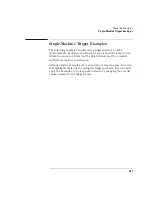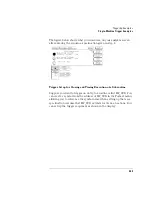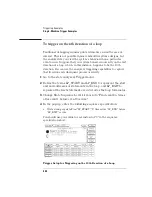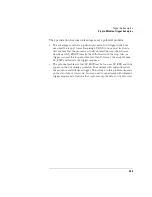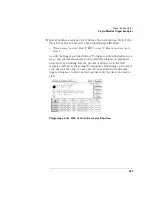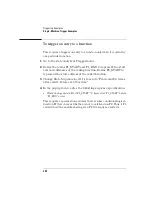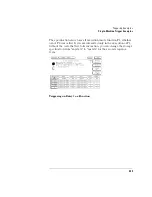
194
Using the Pattern Generator
ASCII File Commands
Any characters that are not valid hexadecimal digits (0 through 9, or
upper/lower case a through f) are ignored and treated as field
separators. This could cause problems if a typo appears in the middle
of a data value (for example, ’12R4’ will be assigned to two labels as ’12’
and ’4’).
The last data row of the file must end with a line termination as this is
the flag to load the data row into the data structure. Failure to do this
will result in a short main program.
When counting file characters be aware of how a particular file
generator (editor) terminates a line. DOS-based systems use two
characters. Be sure to account for line termination character(s) in the
overall file character count.
The ASCII file load mechanism assumes correctness in the data file and
any header commands. Error handling is rather basic, and treating
unexpected characters as field separators could create bizarre results
when parsing the file. Error messages point to the line number where
the parser thinks the error occurred, but the line count may not be
exact because of parsing problems with the data.
When using a LAN interface to send ASCII data, an extra line feed <lf>
is required at the end of the file. This <lf> is NOT included in the
<char_count> value. It is required to ensure the data buffer is flushed.
Serious problems will cause the default main program to be loaded in
an effort to avoid locking up the HP 1660EP-series system.
Summary of Contents for 1670E Series
Page 6: ...6 In This Book...
Page 26: ...26 Contents...
Page 27: ...27 Section 1 Logic Analyzer...
Page 28: ...28...
Page 29: ...29 1 Logic Analyzer Overview...
Page 39: ...39 2 Connecting Peripherals...
Page 49: ...49 3 Using the Logic Analyzer...
Page 72: ...72 Using the Logic Analyzer The Inverse Assembler...
Page 73: ...73 4 Using the Trigger Menu...
Page 101: ...101 5 Using the Oscilloscope...
Page 151: ...151 6 Using the Pattern Generator...
Page 199: ...199 7 Triggering Examples...
Page 237: ...237 8 File Management...
Page 249: ...249 9 Logic Analyzer Reference...
Page 360: ...360 Logic Analyzer Reference The Compare Menu...
Page 361: ...361 10 System Performance Analysis SPA Software...
Page 397: ...397 11 Logic Analyzer Concepts...
Page 430: ...430 Logic Analyzer Concepts The Analyzer Hardware Oscilloscope board theory Oscilloscope board...
Page 439: ...439 12 Troubleshooting the Logic Analyzer...
Page 455: ...455 13 Specifications...
Page 471: ...471 14 Operator s Service...
Page 479: ...479 Operator s Service Troubleshooting Troubleshooting Flowchart 2...
Page 491: ...491 Section 2 LAN...
Page 492: ...492...
Page 493: ...493 15 Introducing the LAN Interface...
Page 497: ...497 16 Connecting and Configuring the LAN...
Page 506: ...506 Connecting and Configuring the LAN Connecting and Configuring the LAN...
Page 507: ...507 17 Accessing the Logic Analyzer File System Using the LAN...
Page 515: ...515 18 Using the LAN s X Window Interface...
Page 527: ...527 19 Retrieving and Restoring Data Using the LAN...
Page 539: ...539 20 Programming the Logic Analyzer Using the LAN...
Page 546: ...546 Programming the Logic Analyzer Using the LAN Programming the Logic Analyzer Using the LAN...
Page 547: ...547 21 LAN Concepts...
Page 555: ...555 22 Troubleshooting the LAN Connection...
Page 580: ...580 Troubleshooting the LAN Connection Getting Service Support...
Page 581: ...581 Section 3 Symbol Utility...
Page 582: ...582...
Page 583: ...583 23 Symbol Utility Introduction...
Page 588: ...588 Symbol Utility Introduction Symbol Utility Introduction...
Page 589: ...589 24 Getting Started with the Symbol Utility...
Page 597: ...597 25 Using the Symbol Utility...
Page 609: ...609 26 Symbol Utility Features and Functions...


